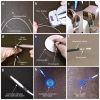Construction of implantable optical fibers for long-term optogenetic manipulation of neural circuits
- PMID: 22157972
- PMCID: PMC8647635
- DOI: 10.1038/nprot.2011.413
Construction of implantable optical fibers for long-term optogenetic manipulation of neural circuits
Abstract
In vivo optogenetic strategies have redefined our ability to assay how neural circuits govern behavior. Although acutely implanted optical fibers have previously been used in such studies, long-term control over neuronal activity has been largely unachievable. Here we describe a method to construct implantable optical fibers to readily manipulate neural circuit elements with minimal tissue damage or change in light output over time (weeks to months). Implanted optical fibers readily interface with in vivo electrophysiological arrays or electrochemical detection electrodes. The procedure described here, from implant construction to the start of behavioral experimentation, can be completed in approximately 2-6 weeks. Successful use of implantable optical fibers will allow for long-term control of mammalian neural circuits in vivo, which is integral to the study of the neurobiology of behavior.
Figures





References
-
- Liewald JF, et al. Optogenetic analysis of synaptic function. Nat. Methods. 2008;5:895–902. - PubMed
Publication types
MeSH terms
Grants and funding
LinkOut - more resources
Full Text Sources
Other Literature Sources

